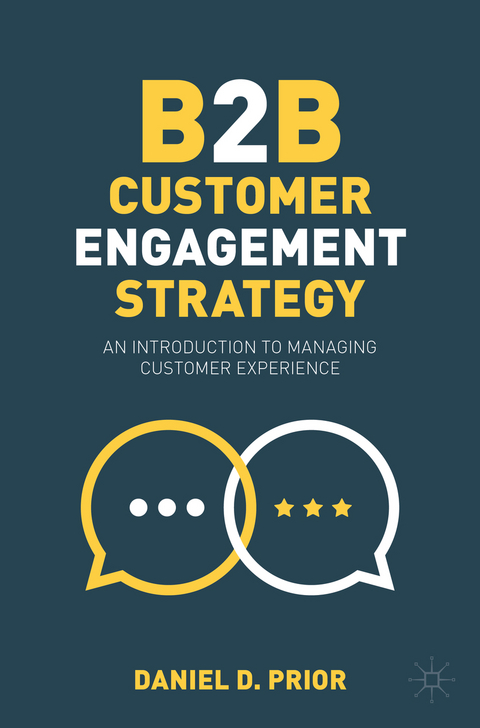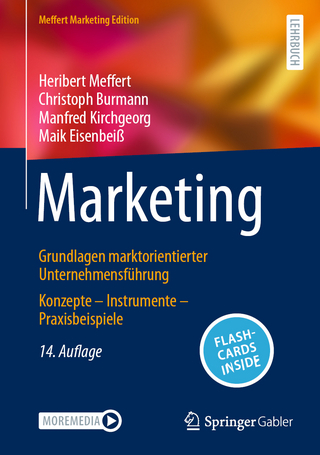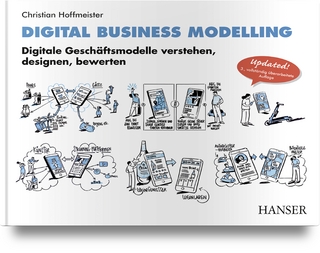
B2B Customer Engagement Strategy
Springer International Publishing (Verlag)
978-3-031-23408-8 (ISBN)
Creating high customer engagement is challenging without a cohesive, strategic approach – particularly in B2B markets. This textbook introduces students to customer engagement strategy in B2B markets, the foundation of which is customer engagement capability. Companies must develop and implement four sub-capabilities – customer journey management, customer relationship management, customer communications and data analytics and insight to succeed.
With a myriad of case studies, discussion questions and prompts for further reading, the textbook translates theory into practice and serves as a useful foundation for executive courses as well as fundamental reading for masters-level specialist courses in customer engagement, marketing, sales, and strategy. In addition, practitioners in supplier firms will also be able to use to build their customer engagement capability.
Daniel D Prior is Associate Professor of Buyer-Supplier Engagement and Deputy Head (Courses) at the UNSW Canberra School of Business, University of New South Wales, Australia and is a Visiting Professor at Cranfield University, UK. Daniel’s work focuses on the factors, the circumstances and the forces that affect the survival of long-term, valuable buyer-supplier relationships in industrial markets.. Prior to academia, Daniel worked for companies such as Acer Computer Australia, KPMG Australia, and General Electric. Daniel received his PhD in 2008 from Macquarie University Australia. Daniel is a Fellow of the Australian Marketing Institute and a Certified Professional Marketer as well as a Member of the Academy of Management and the Academy of Marketing Science. He is also the author of ‘Organisational Buying: A Multidisciplinary Perspective’ (Palgrave Macmillan, 2021).
Preface. i
Acknowledgments. iii
Author Profile. iv
Table of Contents. v
Figures. ix
Tables. ix
Chapter 1 What is Customer Engagement?. 11
1. Introduction. 11
2. Defining CE. 11
2.1. A Definition. 12
3. Key Attributes of CE. 13
3.1. CE centres on a brand. 13
3.2. CE is a psychological state. 14
3.3. CE is an emotional state. 16
3.4. CE is observable in customer behaviour. 17
3.5. A summary of CE key attributes. 19
4. Why CE matters. 20
4.1. The customer’s perspective. 21
4.2. The supplier’s perspective. 22
4.3. The impact on society. 25
5. Getting CE ‘right’ for suppliers. 26
6. Towards CE strategy. 27
6.1. CE strategy involves a long-term orientation. 28
6.2. CE strategy involves the development of capabilities. 29
6.3. CE strategy focuses on the most desirable customers. 32
6.4. CE strategy manipulates CE forms. 33
7. Chapter summary. 34
Discussion Questions. 35
References. 35
Further Reading. 36
Chapter 2 CE Context. 37
1. Introduction. 37
2. What is CE context?. 37
2.1. The properties of CE contexts. 39
2.1.1. Timing. 39
2.1.2. Place. 40
2.1.3. The nature of the product/ service. 41
2.1.4. Familiar versus unfamiliar. 43
2.1.5. Independent versus social 44
2.1.6. A summary of CE contexts. 45
3. The purchase situation. 47
4. Focusing on business-to-business (B2B) CE contexts. 50
4.1. Differences between B2B and B2C CE contexts. 50
4.2. Similarities between B2B and B2C CE contexts. 52
5. B2B CE contexts and organisational buying. 53
6. Chapter Summary. 54
Discussion Questions. 55
References. 55
Chapter 3 Customer Experience (CX) and Customer Journey. 57
1. Introduction. 57
2. CX. 58
2.1. The emergence of CX. 58
2.2. Components of CX. 59
2.2.1. Customer perceptions and expectations. 60
2.2.2. Customer behaviour. 62
2.2.3. Relating customer expectations, perceptions, and behaviours. 63
3. Customer Journey. 66
3.1. Customer journey as a linear process. 66
3.2. Customer journey as a reflexive process. 69
3.3. Customer journey as both linear and reflexive. 72
4. B2B CX and customer journey. 74
5. Chapter Summary. 78
Discussion Questions. 79
References. 79
Chapter 4 The Case for CE Capability. 81
1. Introduction. 81
2. Why we need CE capability. 82
3. Defining CE capabilities. 84
3.1. CE ordinary capabilities. 88
3.2. CE dynamic capabilities. 90
4. Four main CE sub-capabilities. 92
4.1. Customer journey management 93
4.2. Customer relationship management (CRM) 94
4.3. Customer communications. 97
4.4. Customer analytics and insight 99
5. A holistic CE capabilities and sub-capabilities framework. 101
6. Chapter Summary. 103
Discussion Questions. 104
References. 104
Chapter 5 Customer Journey Management. 106
1. Introduction. 106
2. Customer journey and brand touchpoints. 107
2.1. Direct impact, high involvement 107
2.2. Direct impact, low involvement 108
2.3. Indirect impact, high involvement 108
2.4. Indirect impact, low involvement 109
An assessment framework for brand touchpoint impacts and involvement 109
3. The inter-relatedness between brand touchpoints. 113
3.1. Causality. 113
3.2. Probability. 114
4. Customer journey management – navigating the key questions. 115
4.1. How many customer brand touchpoints is ideal?. 115
4.2. What is the composition of each customer brand touchpoint?. 117
4.3. How can we influence the customer to interact with brand touchpoints in ways that are most beneficial?. 121
5. Embedding customer journey management 126
6. Customer journey management as a capability. 130
7. Chapter Summary. 131
Discussion Questions. 132
References. 133
Chapter 6 Customer Relationship Management (CRM) 134
1. Introduction. 134
2. Customer relationships, CRM, and CE. 134
3. CRM as multiple customer journeys. 136
Plotting interactions between customer relationships and customer journeys. 138
4. CRM as a CE sub-capability. 140
4.1. The relational functions of CRM.. 140
4.1.1. Choosing the right customers. 140
4.1.2. Starting, building, keeping, and ending customer relationships. 142
4.2. The technical functions of CRM.. 144
4.2.1. Marketing automation. 144
4.2.2. Sales automation. 146
4.2.3. Service automation. 147
5. The components of a CRM sub-capability. 149
5.1. Customer acquisition. 150
5.2. Customer onboarding. 150
5.3. Customer relationship maintenance. 151
5.3.1. Managing customer enquiries. 152
5.3.2. Enhancing customer relationship value. 153
5.3.3. Enhancing the customer bond. 154
5.4. Customer offboarding. 155
6. Chapter Summary. 156
Discussion Questions. 156
References. 157
Chapter 7 Customer Communications. 158
1. Introduction. 158
2. Defining customer communications. 159
2.1. Message. 159
2.2. Customer communications channels. 162
2.2.1. Asynchronous communications channels. 163
2.2.2. Synchronous communications channels. 164
2.2.3. Hybrid communications channels. 165
2.2.4. Weighing up explicit customer communications channel options 168
2.3. Customer communications frequency. 171
2.4. Customer communications flows. 172
3. Towards a customer communications capability. 173
3.1. Ordinary customer communications capabilities. 174
3.2. Dynamic customer communications capabilities. 175
4. Proactive and reactive customer communications. 176
5. Monitoring and evaluating customer communications. 178
6. Chapter Summary. 180
Discussion Questions. 181
References. 182
Chapter 8 Analytics and Insight. 183
1. Introduction. 183
2. Defining customer analytics, customer insight and business intelligence. 184
2.1. Customer analytics – what it is, what it is not 185
2.2. Customer insight – what it is, what it is not 185
2.3. Business intelligence – what it is, what it is not 186
3. The components of a customer analytics and insight CE sub-capability 188
3.1. Problem definition. 188
3.2. Planning. 190
3.3. Operations. 191
3.3.1. Data collection. 192
3.3.2. Analysis. 197
3.3.3. Reporting Insights. 201
3.3.3.1. Insights and the time-poor manager. 201
3.3.3.2. Insights and the ignorant manager. 202
3.3.3.3. Insights and corporate crises. 202
3.3.3.4. Insights and the proactive manager. 203
4. Implementing customer analytics and insight – some considerations 204
5. Chapter Summary. 205
Discussion Questions. 206
Chapter 9 CE Capability Maturity. 207
1. Introduction. 207
2. CE capability and its maturity. 208
2.1. CE sub-capability internal consistency decision areas. 209
2.2. CE sub-capability horizontal consistency decision areas. 210
3. Gauging CE capability maturity. 217
3.1. Scenario 1 – Low internal consistency, low horizontal consistency. 217
3.2. Scenario 2 – Low internal consistency, high horizontal consistency 218
3.3. Scenario 3 – High internal consistency, low horizontal consistency 218
3.4. Scenario 4 – High internal consistency, high horizontal consistency 219
3.5. The importance of context 221
4. Developing the CE capability. 221
4.1. Step 1: Build internal consistency first 222
4.2. Step 2: Build horizonal consistency. 224
4.3. Dealing with constraints. 225
5. CE capability performance assessment 227
5.1.1. CE performance tensions. 227
5.1.2. CE performance metrics. 229
5.1.2.1. Aggregate level CE performance metrics. 229
5.1.2.2. Specific level CE performance metrics. 230
5.1.2.3. A word on optimising CE performance assessment 230
6. Chapter Summary. 231
Discussion Questions. 232
Chapter 10 Current Issues in CE. 233
1. Introduction. 233
2. Customer engagement and VUCA. 233
3. Emerging issues affecting CE. 234
4. CE developments. 236
5. The next steps. 237
6. Chapter Summary. 239
References. 239
Index. 240
| Erscheinungsdatum | 06.04.2023 |
|---|---|
| Zusatzinfo | Illustrationen |
| Verlagsort | Cham |
| Sprache | englisch |
| Maße | 155 x 235 mm |
| Gewicht | 378 g |
| Einbandart | kartoniert |
| Themenwelt | Wirtschaft ► Betriebswirtschaft / Management ► Marketing / Vertrieb |
| Schlagworte | customer insight • Customer Orientation • Digital Marketing • Marketing strategy • Sales Management |
| ISBN-10 | 3-031-23408-1 / 3031234081 |
| ISBN-13 | 978-3-031-23408-8 / 9783031234088 |
| Zustand | Neuware |
| Haben Sie eine Frage zum Produkt? |
aus dem Bereich


